Intel's Pentium 4 670: Just Another Speed Bump
by Derek Wilson on May 26, 2005 9:00 AM EST- Posted in
- CPUs
Workstation Applications
SPECviewperf 8
SPECviewperf is a collection of application traces taken from some of the most popular professional applications, and compiled together in a single set of benchmarks used to estimate performance in the various applications in which the benchmark is used to model. With version 8, SPEC has significantly improved the quality of the benchmark, making it even more of a real world indicator of performance.We have included SPEC's official description of each one of the 8 tests in the suite.
3dsmax Viewset (3dsmax-03)
"The 3dsmax-03 viewset was created from traces of the graphics workload generated by 3ds max 3.1. To insure a common comparison point, the OpenGL plug-in driver from Discreet was used during tracing.
The models for this viewset came from the SPECapc 3ds max 3.1 benchmark. Each model was measured with two different lighting models to reflect a range of potential 3ds max users. The high-complexity model uses five to seven positional lights as defined by the SPECapc benchmark and reflects how a high-end user would work with 3ds max. The medium-complexity lighting models uses two positional lights, a more common lighting environment.
The viewset is based on a trace of the running application and includes all the state changes found during normal 3ds max operation. Immediate-mode OpenGL calls are used to transfer data to the graphics subsystem."
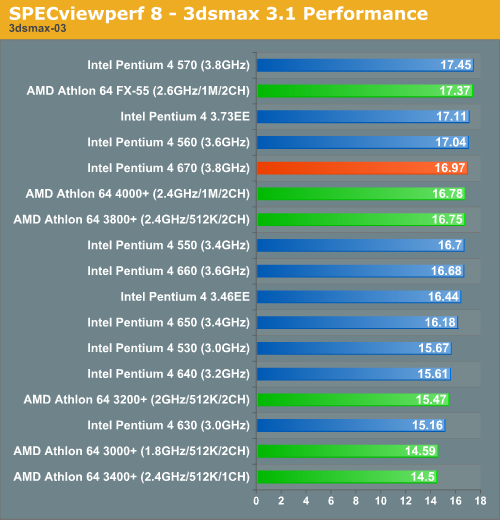
CATIA Viewset (catia-01)
"The catia-01 viewset was created from traces of the graphics workload generated by the CATIATM V5R12 application from Dassault Systems.
Three models are measured using various modes in CATIA. Phil Harris of LionHeart Solutions, developer of CATBench2003, supplied SPEC/GPC with the models used to measure the CATIA application. The models are courtesy of CATBench2003 and CATIA Community.
The car model contains more than two million points. SPECviewperf replicates the geometry represented by the smaller engine block and submarine models to increase complexity and decrease frame rates. After replication, these models contain 1.2 million vertices (engine block) and 1.8 million vertices (submarine).
State changes as made by the application are included throughout the rendering of the model, including matrix, material, light and line-stipple changes. All state changes are derived from a trace of the running application. The state changes put considerably more stress on graphics subsystems than the simple geometry dumps found in older SPECviewperf viewsets.
Mirroring the application, draw arrays are used for some tests and immediate mode used for others."
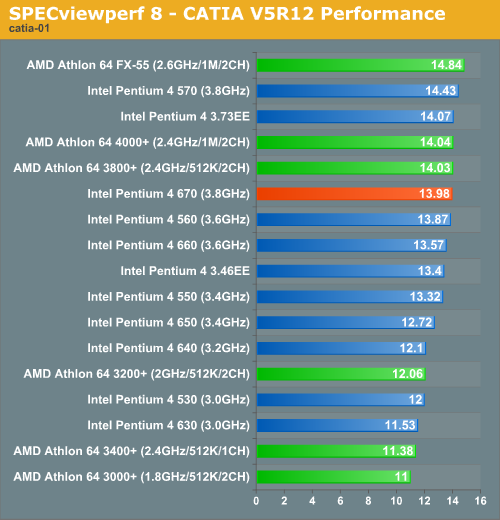
Lightscape Viewset (light-07)
"The light-07 viewset was created from traces of the graphics workload generated by the Lightscape Visualization System from Discreet Logic. Lightscape combines proprietary radiosity algorithms with a physically based lighting interface.
The most significant feature of Lightscape is its ability to accurately simulate global illumination effects by precalculating the diffuse energy distribution in an environment and storing the lighting distribution as part of the 3D model. The resulting lighting "mesh" can then be rapidly displayed."
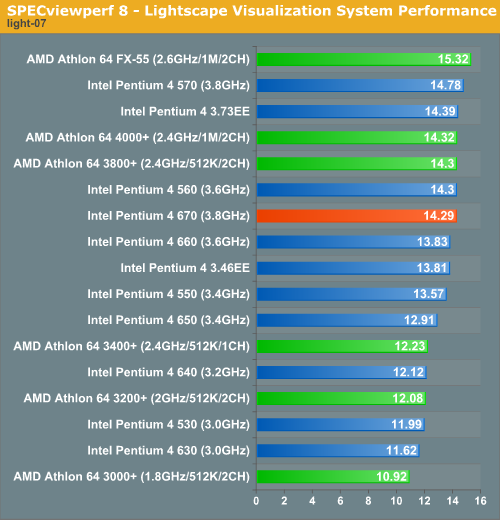
Maya Viewset (maya-01)
"The maya-01 viewset was created from traces of the graphics workload generated by the Maya V5 application from Alias.
The models used in the tests were contributed by artists at NVIDIA. Various modes in the Maya application are measured.
State changes as made by the application are included throughout the rendering of the model, including matrix, material, light and line-stipple changes. All state changes are derived from a trace of the running application. The state changes put considerably more stress on graphics subsystems than the simple geometry dumps found in older viewsets.
As in the Maya V5 application, array element is used to transfer data through the OpenGL API."

Pro/ENGINEER (proe-03)
"The proe-03 viewset was created from traces of the graphics workload generated by the Pro/ENGINEER 2001TM application from PTC.
Two models and three rendering modes are measured during the test. PTC contributed the models to SPEC for use in measurement of the Pro/ENGINEER application. The first of the models, the PTC World Car, represents a large-model workload composed of 3.9 to 5.9 million vertices. This model is measured in shaded, hidden-line removal, and wireframe modes. The wireframe workloads are measured both in normal and antialiased mode. The second model is a copier. It is a medium-sized model made up of 485,000 to 1.6 million vertices. Shaded and hidden-line-removal modes were measured for this model.
This viewset includes state changes as made by the application throughout the rendering of the model, including matrix, material, light and line-stipple changes. The PTC World Car shaded frames include more than 100MB of state and vertex information per frame. All state changes are derived from a trace of the running application. The state changes put considerably more stress on graphics subsystems than the simple geometry dumps found in older viewsets.
Mirroring the application, draw arrays are used for the shaded tests and immediate mode is used for the wireframe. The gradient background used by the Pro/E application is also included to better model the application workload."
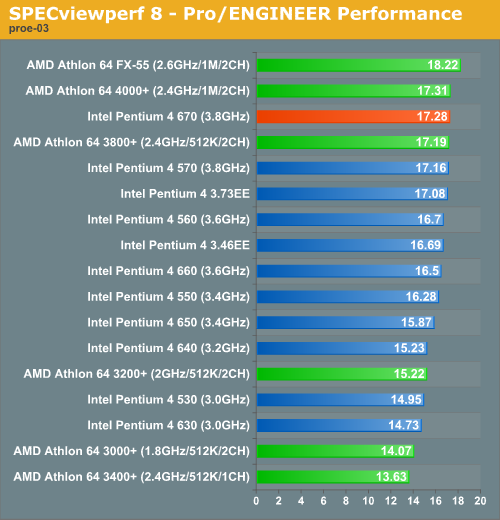
SolidWorks Viewset (sw-01)
"The sw-01 viewset was created from traces of the graphics workload generated by the Solidworks 2004 application from Dassault Systemes.
The model and workloads used were contributed by Solidworks as part of the SPECapc for SolidWorks 2004 benchmark.
State changes as made by the application are included throughout the rendering of the model, including matrix, material, light and line-stipple changes. All state changes are derived from a trace of the running application. The state changes put considerably more stress on graphics subsystems than the simple geometry dumps found in older viewsets.
Mirroring the application, draw arrays are used for some tests and immediate mode used for others."
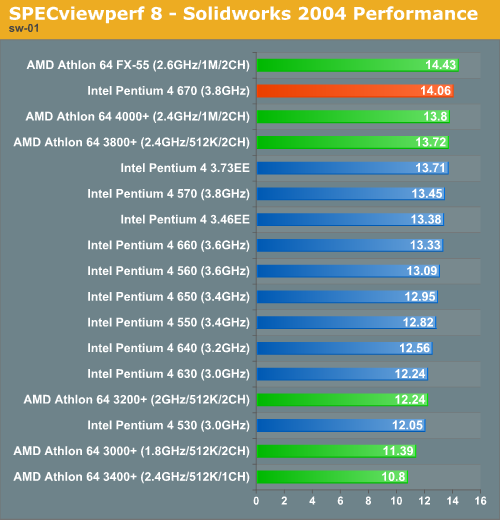
Unigraphics (ugs-04)
"The ugs-04 viewset was created from traces of the graphics workload generated by Unigraphics V17.
The engine model used was taken from the SPECapc for Unigraphics V17 application benchmark. Three rendering modes are measured -- shaded, shaded with transparency, and wireframe. The wireframe workloads are measured both in normal and anti-alised mode. All tests are repeated twice, rotating once in the center of the screen and then moving about the frame to measure clipping performance.
The viewset is based on a trace of the running application and includes all the state changes found during normal Unigraphics operation. As with the application, OpenGL display lists are used to transfer data to the graphics subsystem. Thousands of display lists of varying sizes go into generating each frame of the model.
To increase model size and complexity, SPECviewperf 8.0 replicates the model two times more than the previous ugs-03 test."
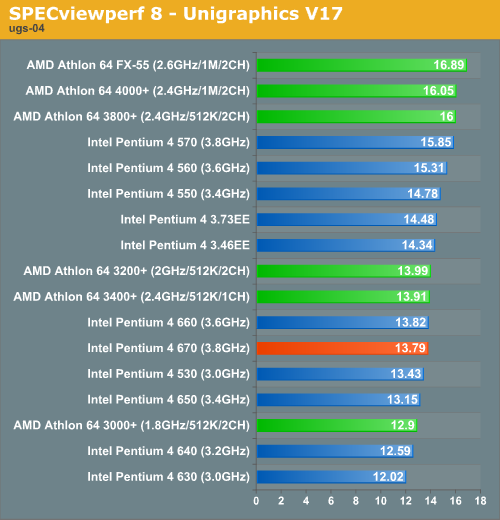










33 Comments
View All Comments
Gatak - Saturday, May 28, 2005 - link
DRM!http://www.digitmag.co.uk/news/index.cfm?NewsID=49...
Seems as the new Intel CPUs and Chiptsets are DRM enabled in hardware now!
Icehawk - Saturday, May 28, 2005 - link
There were some odd results IMO, at least one test were the 660 was faster than the 670. Eh?Remember the good old days when a processor that cost more and was rated higher was just plain faster? :D
When is Anandtech going to update the version of ACDSee used? It is 2 versions old :(
The DvD - Saturday, May 28, 2005 - link
#28: Then you effectively reviewed the 945 board, and not the cpu. Because the 670 would only be 5.5% faster max. than the 660. Perhaps the graphs could be changed to say '670 (945)' for the new Intel combo.RockHydra11 - Friday, May 27, 2005 - link
C'mon Intel. Exnay on the escotpreyacoub - Friday, May 27, 2005 - link
20 - Posted on May 26, 2005 at 8:33 PM by flatblastard Reply#10 "don't forget, a 200 MHz increase with AMD cpus is like a 300+ MHz increase for intel"
#13 Also consider the fact that 200 "A64 Mhz" aren't equal to 200 "P4 MHz"
I am aware of this, and I will now make you aware of the fact that I can afford to have 10 less FPS.
-------------
Ah, so in that case you CERTAINLY wouldn't buy this more expensive 670 chip that doesn't even always outperform slower Intel ones.
DerekWilson - Friday, May 27, 2005 - link
The 670 was the only board to use the 945 chipset and latest drivers from Intel. This could account for the odd Nero and Winzip numbers. I'm speaking more of the drivers than the hardware.Derek Wilson
mjz - Friday, May 27, 2005 - link
#20.. I don't understand, why would you want to buy a CPU that is slower than a cheaper alternative.. That being, AMD. Faster, cheaper, why not?JarredWalton - Friday, May 27, 2005 - link
23 - I'm almost positive that the 4000+ used was an older Sledgehammer core. As far as I know, no one at AnandTech has a San Diego yet.Murst - Friday, May 27, 2005 - link
I really don't understand why so many people complain/laugh at/question CPU releases. Everyone should be happy that another CPU is out on the market. The more are out there (especially of the upper end processors), the faster the price will drop.We'll have to wait and see if other sites get the same differences in the 6xx family before jumping to conclusions, but it sure does seem very strange....
Zebo - Friday, May 27, 2005 - link
No X2 in there?Well I guess Intel has to win a couple benchmarks..and technically the X2 processor is'nt really "out" yet.:D
But niether is 670...